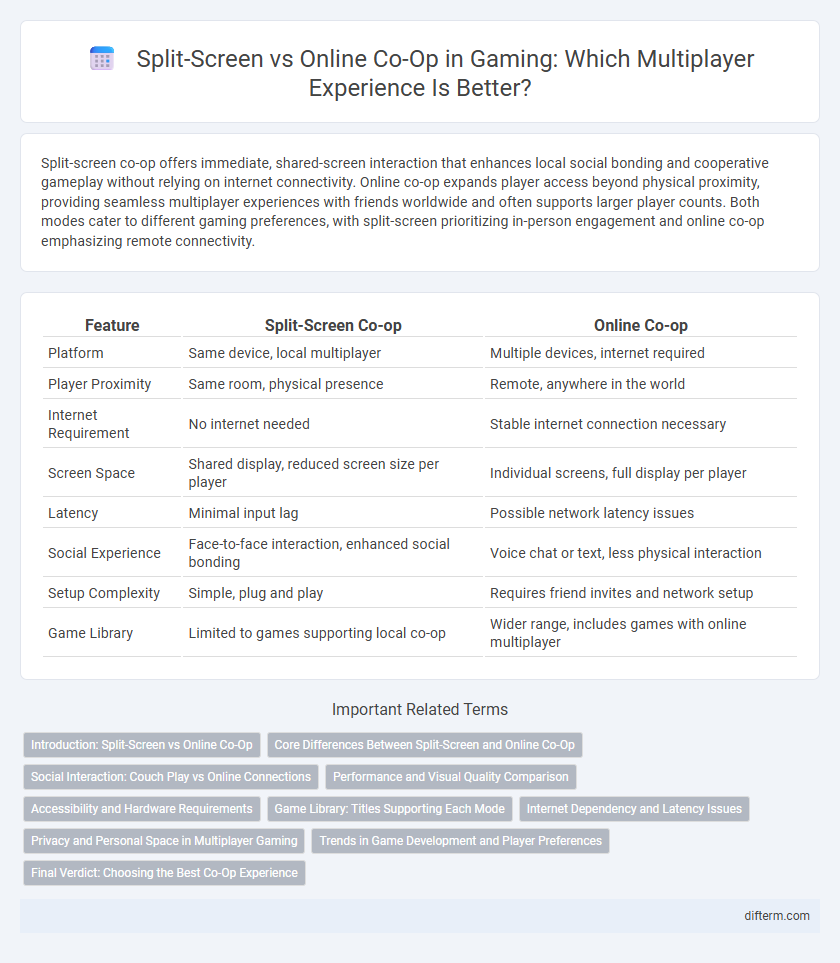Split-screen co-op offers immediate, shared-screen interaction that enhances local social bonding and cooperative gameplay without relying on internet connectivity. Online co-op expands player access beyond physical proximity, providing seamless multiplayer experiences with friends worldwide and often supports larger player counts. Both modes cater to different gaming preferences, with split-screen prioritizing in-person engagement and online co-op emphasizing remote connectivity.
Table of Comparison
| Feature | Split-Screen Co-op | Online Co-op |
|---|---|---|
| Platform | Same device, local multiplayer | Multiple devices, internet required |
| Player Proximity | Same room, physical presence | Remote, anywhere in the world |
| Internet Requirement | No internet needed | Stable internet connection necessary |
| Screen Space | Shared display, reduced screen size per player | Individual screens, full display per player |
| Latency | Minimal input lag | Possible network latency issues |
| Social Experience | Face-to-face interaction, enhanced social bonding | Voice chat or text, less physical interaction |
| Setup Complexity | Simple, plug and play | Requires friend invites and network setup |
| Game Library | Limited to games supporting local co-op | Wider range, includes games with online multiplayer |
Introduction: Split-Screen vs Online Co-Op
Split-screen gaming offers local cooperative play by displaying multiple player perspectives on a single screen, enhancing social interaction and immediate feedback. Online co-op enables players to connect remotely, expanding multiplayer possibilities beyond physical proximity with seamless matchmaking and larger player bases. Both modes cater to different gaming preferences, impacting latency, communication, and overall user experience.
Core Differences Between Split-Screen and Online Co-Op
Split-screen gaming enables multiple players to play simultaneously on the same device, offering immediate physical proximity and shared screen real estate, which can impact player interaction and field of vision. Online co-op, conversely, connects players across different devices and locations via the internet, providing greater flexibility and range but potentially introducing latency issues and requiring stable network connections. The core differences center on social dynamics, technical requirements, and gameplay experience influenced by hardware constraints versus online infrastructure.
Social Interaction: Couch Play vs Online Connections
Split-screen co-op fosters immediate social interactions through shared physical space, enhancing communication with direct eye contact and spontaneous reactions. Online co-op expands social connectivity by enabling players to join from different locations, increasing diversity and inclusivity despite limited face-to-face interaction. Both modes offer distinct social experiences that cater to varied player preferences in multiplayer gaming.
Performance and Visual Quality Comparison
Split-screen co-op often struggles with reduced frame rates and lower resolution due to rendering multiple views on a single console, resulting in compromised visual quality. Online co-op leverages separate hardware for each player, maintaining higher frame rates and better graphics fidelity without taxing a single system's resources. Performance benchmarks consistently show online co-op offering smoother gameplay and sharper visuals compared to split-screen modes.
Accessibility and Hardware Requirements
Split-screen co-op offers immediate accessibility without the need for internet connectivity, requiring only a single console and multiple controllers, making it ideal for local multiplayer sessions. Online co-op demands stable high-speed internet, individual gaming devices, and often additional subscriptions, which can limit access for players with weaker hardware or unstable connections. The choice between split-screen and online co-op heavily influences accessibility based on players' hardware capabilities and network infrastructure.
Game Library: Titles Supporting Each Mode
Split-screen co-op offers a curated selection of classic and modern titles optimized for local multiplayer, such as Halo: The Master Chief Collection and Borderlands 3, ensuring seamless shared-screen gameplay. Online co-op boasts a vastly larger game library with popular franchises like Destiny 2, Warframe, and Gears 5, providing expansive multiplayer experiences unrestricted by physical proximity. Game availability varies widely, making it essential to check specific title support before choosing between split-screen and online co-op modes.
Internet Dependency and Latency Issues
Split-screen co-op gaming eliminates internet dependency by allowing players to share the same physical console, ensuring zero latency and seamless real-time interaction. Online co-op requires a stable internet connection, where high latency and packet loss can cause lag, disrupting synchronization and damaging the gaming experience. Local split-screen remains the optimal choice for latency-sensitive games, while online co-op offers broader accessibility at the risk of network-induced performance issues.
Privacy and Personal Space in Multiplayer Gaming
Split-screen gaming allows players to maintain privacy and personal space by physically sharing the same environment while controlling separate screens, reducing exposure to online risks. Online co-op connects players digitally, which can expose personal data to cyber threats and compromises the sense of personal boundaries. Managing privacy settings and using secure networks are essential for protecting personal information in online multiplayer environments.
Trends in Game Development and Player Preferences
Split-screen co-op remains popular for local multiplayer experiences, fostering social interaction and nostalgia, while online co-op caters to a growing demand for remote collaboration and expansive player networks. Recent game development trends emphasize cross-platform compatibility and cloud gaming integration, enabling seamless online co-op across diverse devices. Player preferences increasingly favor online co-op for convenience and connectivity, though split-screen maintains appeal in party and couch gaming scenarios.
Final Verdict: Choosing the Best Co-Op Experience
Split-screen co-op offers immediate social interaction and nostalgic appeal, ideal for local multiplayer sessions with friends or family. Online co-op provides flexibility and accessibility, connecting players globally with seamless synchronization and expansive multiplayer options. Evaluating your priorities in social dynamics, gameplay convenience, and hardware availability will guide you to the best co-op experience for your gaming needs.
split-screen vs online co-op Infographic

 difterm.com
difterm.com